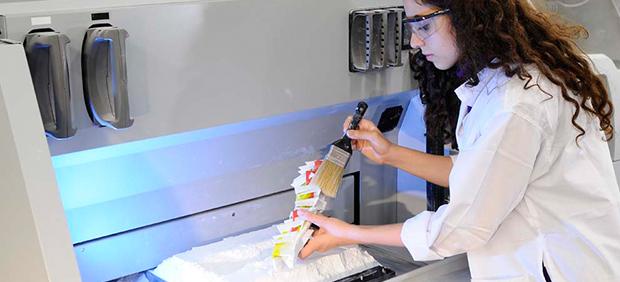3D Printing Lab

3D printing is an additive manufacturing process. This means materials such as plastic and resin can be “printed” in layers to gradually build up and form complex structures and objects.
Our 3D printers use several types of materials, including plastics, resin and powder, and can be used for both prototyping and production.
Machine Specifications
- BAMBU LABS X1 CARBON
The X1 Carbon is a premium plastic extrusion printer capable of high-speed printing. X1 Carbon printers have an enclosed build chamber and a heated bed that reduce chances of warped prints. 3D models should be made solid and can have overhangs as support and infill is auto genereted.
The minimum recommended thickness is 1.5mm, with a maximum build envelope of 245mm x 245mm x 250mm. Layer resolution is 0.1 mm.
- PROJET 660
The PROJET 660 printer uses a high-strength gypsum composite powder. The printer uses a specially designed glue to bond the powder together. Models should be made hollow leaving enough wall thickness for strength.
The minimum thickness will vary based on structure, and size of model. The minimum recommended thickness is 2–3 mm, with a maximum build envelope of 370mm x 245mm x 190mm. Layer Resolution is 0.1 mm. Finishes include natural finish, ZBond and waxed.
- MJP 3600
The ProJet MJP 3600 Series is a plastic multi-material 3D printer series and the latest in 3D Systems’ MultiJet Printing (MJP) line of 3D printers. This MultiJet device was designed to create high-fidelity and high-performance parts.
The minimum recommended thickness is 1mm for walls and 2mm for horizontal elements. The maximum build envelope is 290mm x 175m m x 195mm, and a layer resolution of 0.03mm.
- Form Labs 3L
The Form 3L is an SLA resin printer capable of printing large models as well as detailed small models. Two individual light sources ensure high print quality near the edges of the print bed.
The minimum recommended thickness is 1-2 mm, with a maximum build envelope of 325mm x 190mm x 290mm.
- Fuse 1
The Fuse 1 Series is a selective laser sintering (SLS) platform that uses specially designed powders to achieve detailed prints with very low waste. Models could be made hollow leaving enough wall thickness for strength and overhangs can be printed without support.
The minimum recommended thickness is 1mm for walls and 1.5mm for horizontal elements. The maximum build envelope is 155mm x 155m m x 290mm, and a layer resolution of 0.1 mm.
Procedure
- Once STL file integrity is verified (watertight, closed geometries, no holes, etc.), download and fill out the 3D Print Submission Form.
- Send the filled form to [email protected], indicating which 3D printer you want to use in the email subject line.
- Drop your *.STL file in the CAAD Labs Students “classes” folder. Emailed files or native digital model files will not be accepted.
Access
Students do not have access to this lab. Files are run by CAAD Labs staff and trained lab assistants only. Please contact our Digital Fabrication Labs Specialist for additional information.
Lab Policies
Please refer to Appendix C of the CAAD Labs’ Policies and Procedures Manual for this lab’s policies, along with other general lab policies.
*AUS login credentials required to access the document

